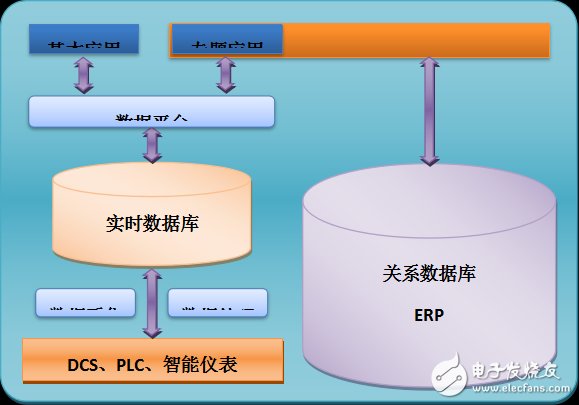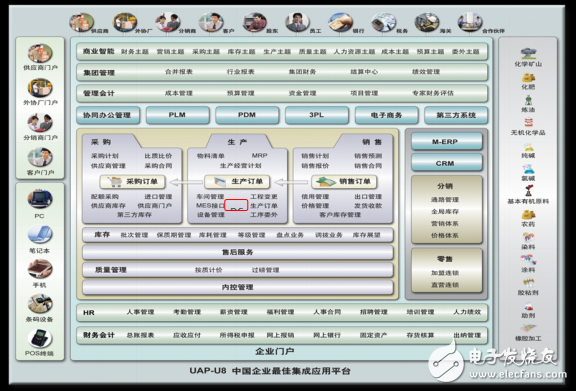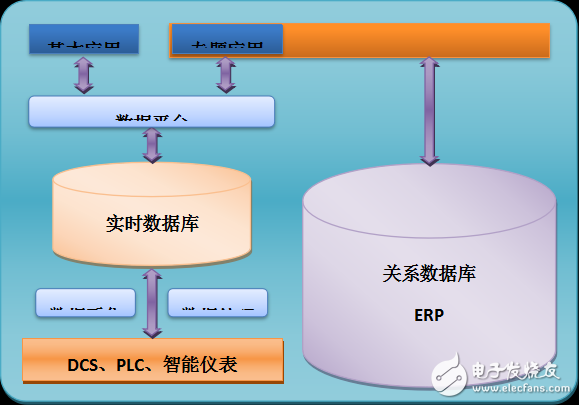**DCS and ERP Integrated Application Solutions**
**Chapter 1: Overview**
In chemical enterprises, production automation control (DCS) and management information systems (ERP) are typically separate from each other. As a result, the data collected by management is often done manually through reports, phone calls, or other outdated methods, which leads to fragmented, delayed, and incomplete insights into the overall production process. This lack of real-time visibility makes it difficult for companies to manage operations efficiently.
The UFIDA DCS and ERP integrated application solution addresses this challenge by automatically collecting, filtering, storing, and analyzing production data through DCS interfaces. It integrates this data into the ERP system, enabling users to access, view, analyze, control, and manage production information in real time. By combining the real-time capabilities of DCS with the business processes of ERP, the solution offers multiple practical applications that enhance operational efficiency and decision-making.

**Chapter 2: Management Requirements for DCS and ERP Integration**
During the production process, computers are primarily used in two areas: production automation control (DCS) and management information systems (ERP), along with office automation (OA). These represent the control layer and management layer of an enterprise’s IT infrastructure.
Process control systems in the process industry are complex, integrated automation systems that cover all aspects of production activities. As a key tool, DCS (Control Layer) performs essential functions such as basic control, real-time data collection, and dynamic monitoring within the industrial production process.
Currently, many process-oriented enterprises still face challenges where the control layer and management layer are disconnected. To overcome this, establishing an integrated production data platform is crucial. This platform connects the management network with the operation control layer, enabling interconnection of control networks and data sharing. It also supports the collection and storage of real-time DCS data from various devices and allows for advanced real-time data applications, which are essential for modern enterprises.
The DCS and ERP integrated application solution should meet the following functional requirements:
- DCS raw data collection and delivery
- Flow chart configuration and browsing
- Trend graph and historical data viewing
- Production data analysis and statistics
- Customized production reports
- Customizable production abnormal alarms
- Data exchange and integration with ERP
- Data grouping based on user needs
- Multi-level user rights management
- Data backup and recovery
- Unidirectional data communication
- Real-time data server with millisecond response
- Multi-user concurrent support
- Scalable database points and collection devices
- System event logging
- System security features
- Fault recovery mechanisms
**Chapter 3: Solutions**
**3.1 Overall Solution**

**3.1.1 Solution Architecture**
The UFIDA DCS and ERP integrated application solution automates the collection of production data, filters, stores, and intelligently analyzes it via DCS interfaces. It then integrates this data into ERP business applications, allowing users to collect, store, view, analyze, control, and manage enterprise production information through the ERP system. By leveraging the real-time nature of DCS data, the solution provides a range of practical applications that improve operational efficiency and decision-making.
- A management system based on data acquisition, secondary applications, and ERP integration
- Real-time monitoring of production processes, historical traceability, report analysis, and operational guidance
- Combining manual data like inspection records and production logs to generate comprehensive and accurate production data
- Implementation of thematic applications for production, equipment, quality, and performance evaluation

**Data Acquisition** communicates with the production automation control system to retrieve real-time production data. The sources of real-time data typically include DCS, PLC, SCADA, HMI, conventional instruments, smart meters, online or offline analytical instruments, level gauges, and inspection tools. Among these, DCS and PLC are the primary data sources.
The interface formats for real-time production data include OPC, DDE, NETDDE, RS-232, RS-422, RS-485, TCP, UDP, etc. OPC is a standard and universal interface that is independent of the data source.
**Data Processing** involves handling both real-time and historical production data in a real-time database, including data storage, backup, and archiving. This ensures that the data is always available for analysis and reporting.
Cadillac Dash Cam,Wireless Dash Cam Front And Back,Front And Rear View Dash Cam,Dash Cam Front
SHENZHEN ROSOTO TECHNOLOGY CO., LTD. , https://www.rdtkdashcam.com